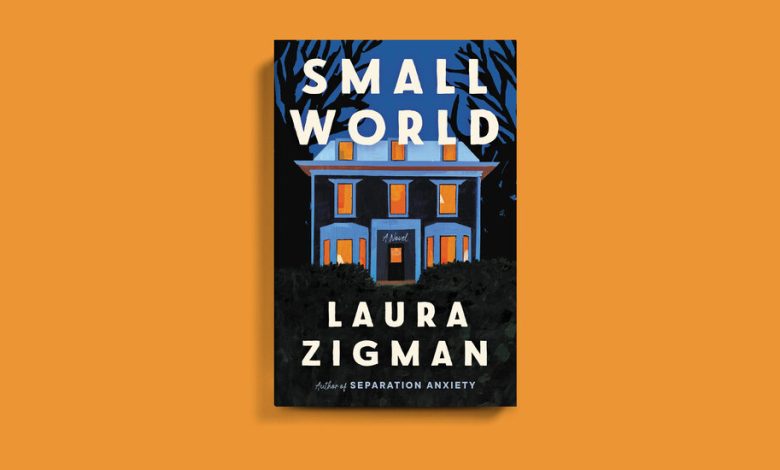How Does a Family Change After Losing a Child?

Welcome to Group Text, a monthly column for readers and book clubs about the novels, memoirs and story collections that make you want to talk, ask questions and dwell in another world for a little bit longer.
________

When a pair of sisters move in together as adults, they finally try to make sense of all that was missing from their childhood — and what was left unsaid.

Zigman takes one of the saddest subjects imaginable, infuses it with humor and warmth, and raises important questions about how families heal (or don’t).
Sometimes you have a gut sense as a reader that it took a long time for a writer to summon the courage to tackle a subject. As I read the four-page introduction to SMALL WORLD (Ecco, 304 pp., $27.99), Laura Zigman’s sixth novel, I could practically see her pinch her eyes shut, suck in a breath and say, “Let’s do this.”
What follows is a graceful swan dive into the question of how a family rearranges itself after the death of a child. Is it possible to truly recover? How are survivors supposed to answer the question of how many siblings they have? If you’re an avid acknowledgments reader like me, you’ll learn that Zigman’s oldest sister, Sheryl, died at age 7. “Small World” is definitely a novel, but some details are clearly pulled from real life.
When we meet the Mellishmans in the 1970s, they are a family of five. There’s Lenny, an orthodontist, and his wife, Louise, “who didn’t graduate from college and barely knows how to boil an egg but never takes no for an answer”; and their daughters, Lydia, Eleanor and Joyce. Eleanor, who was born with cerebral palsy and a seizure disorder, dies only a year after her parents reluctantly send her to the Walter E. Fernald State School, once known as the Massachusetts School for the Feeble-Minded.
Our narrator, Joyce, sums up the aftermath of this loss using the technical term for crooked teeth: “You are born into malocclusion. Into an unlucky family with a disabled child, then a dead child. The hole caused by her absence will eventually cause everything and everyone to shift, and drift, the same way teeth do, after an extraction.” Lenny and Louise never recover; he dies of a drug overdose that may or may not be accidental and she channels her heartbreak into all-consuming activism on behalf of disabled children. Lydia alights for California as soon as she graduates from art school. And Joyce spends as much time as possible at friends’ houses, scrutinizing their framed family photos with the zeal of a detective on the trail of a promising lead.
“Small World” begins when the surviving sisters reunite as adults — middle-aged, divorced, living together in Joyce’s apartment while Lydia sets up her post-marriage life on the East Coast. Their awkward navigation of close quarters and attempts to make peace with their childhood are the sturdy foundation holding up Zigman’s plot. Appropriately, one of her epigraphs is from Adrienne Rich’s “Diving Into the Wreck.”
There are three other load-bearing walls that do the trick but occasionally feel as if they’re blocking the view. First, Zigman introduces new upstairs neighbors who generate a mysterious racket that turns out to be a yoga studio; their presence threatens to drive an even bigger wedge between Joyce and Lydia. Next, we have Joyce’s job as an archivist for EverMore, a company that digitizes photos and compiles slide shows for weddings and bat mitzvahs. The work scratches her voyeuristic itch, but it’s clear that Joyce is too invested in her clients’ lives — to the extent that she doctors snapshots to include things like seatbelts and toddler gates.
And finally, there’s Joyce’s hobby: using posts from Small World, a Nextdoor-like app, to create found poetry. (“A brown paper bag of avocados/from the local farmer’s market/was stolen/from our porch/where we’d left them to ripen.”) These snippets of verse provide a window on local machinations — the neighbors have a lot of thoughts on everything from weeds to wild turkeys — but sometimes they’re more of a distraction than a tension breaker.
As Joyce and Lydia circle around their memories of Eleanor’s departure and death, I thought of the last stanza of Rich’s poem: “We are, I am, you are/by cowardice or courage/the one who find our way/back to this scene/carrying a knife, a camera/a book of myths/in which/our names do not appear.” In Zigman’s brave and heartfelt book of truths, the names of all three Mellishman sisters are indelible.
Discussion Questions
-
How has the famous “Mellishman Luck” changed (in more ways than one) by the end of “Small World”?
-
Why do you think EverMore and Small World are so important to Joyce?
Suggested Reading
“The Vanishing Half,” by Brit Bennett. In this novel, which was named one of our 10 Best Books of 2020, twin sisters run away from a life of domestic service in Mallard, La., to the glittering promise of New Orleans, where their paths diverge. Bennett writes, “Stella became white and Desiree married the darkest man she could find.” Their dramatically different choices, priorities and penchants for deception come to a head when the next generation starts asking questions.
“Sorrow and Bliss,” by Meg Mason. As soon as I finished Mason’s tragically funny debut novel, I gave it to a friend, bookmark and all. I have a feeling my much-underlined paperback has changed hands a dozen times by now; “Sorrow and Bliss” is too good to hang on to. A depressed 40-year-old named Martha Friel returns to her parents’ house after her husband leaves her. Her own sister has given up on her. Her cousin advises her to figure out “why you keep burning your own house down.” Martha’s challenges are as complicated and deep-seated as Joyce Mellishman’s, and Mason navigates them with dark charm that gave me déjà vu while reading “Small World.”




